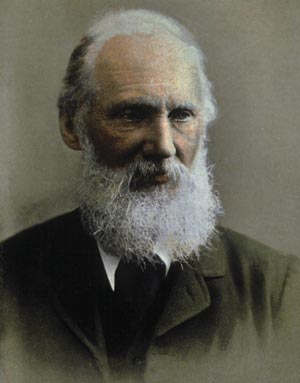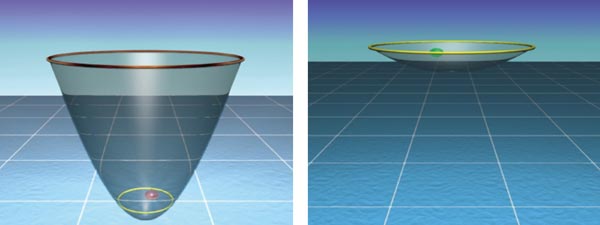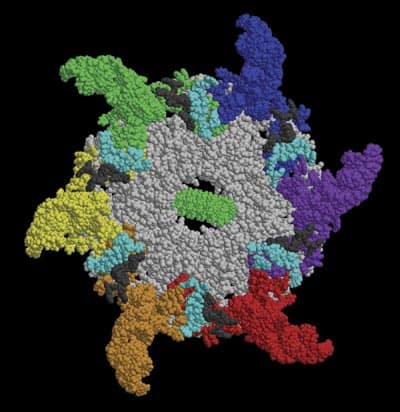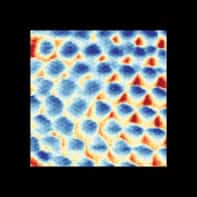A century after his death, Kelvin's pioneering work in thermodynamics – which underpinned the Industrial Revolution – is being mirrored by researchers exploring the biological engines that power life itself, as Mark Haw describes
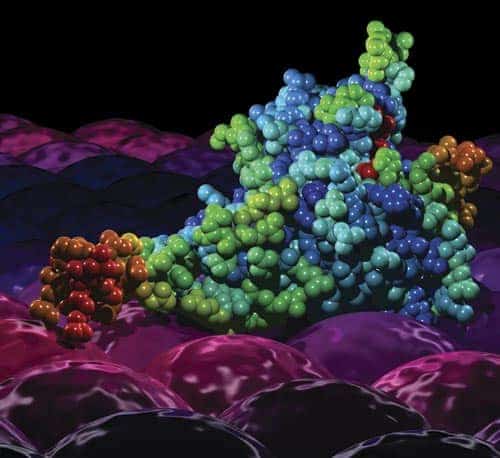
To most physicists, the phrase “theory of everything” refers to a unified theory of nature’s fundamental interactions, the quest for which has kept researchers busy for the best part of a century. With talk of superstrings, multiverses and 11D space–time, theories of everything can seem very much the stuff of the 21st century, of the almost “anything goes” frontiers of mind-boggling mathematics and theoretical physics.
Yet there is a different kind of theory of everything that dates back to the middle of the 19th century. While superstring theory aims to tell us what everything is, this Victorian theory is more a theory of what everything does. And despite its age, the theory is now promising a 21st-century revolution in the way we understand the complex functions of life itself.
This theory of everything is otherwise known as thermodynamics: the theory of energy. Everything that happens in the universe — from boiling an egg to the rotation of galaxies — involves the transformation of energy. Ergo, a theory that explains how energy is transformed in order to change the state, arrangement or composition of matter is a theory of everything that happens.
The beginnings of the science of energy date from the height of the Victorian age 150 years ago, and in particular to William Thomson (better known as Lord Kelvin). Kelvin, who died 100 years ago on 17 December 1907, became professor of natural philosophy at Glasgow University at the age of 22, and went on to become a quintessential grandee of Victorian science, ennobled peer and holder of a fistful of innovative patents (see “Kelvin: the man behind the title”). While he made major contributions to an astonishingly wide range of fields, Kelvin’s most significant role was the development, alongside figures such as Rudolf Clausius, Sadi Carnot and James Joule, of thermodynamics.
Although Newton had previously made great progress in understanding the concepts of forces and gravity, energy was almost entirely a mystery at the beginning of the 19th century. The laws of thermodynamics, which Kelvin and Clausius had developed to understand the nature of heat and the meaning of temperature, gave hard definition to energy and the rules by which it could be transformed. In fact, thermodynamics ended up being a scientific revolution every bit as significant as Newton’s laws or the rise of quantum physics in the first half of the 20th century.
But Kelvin’s thermodynamic revolution was only the beginning. Today, new research into the physics of living systems and nanotechnology is challenging the limitations of that 19th-century theory. A century after Kelvin’s death, researchers are creating a second revolution in how we understand the nature of energy.
Energy and industry
Newtonian mechanics changed the way we see the world by turning the concept of force into a precise mathematical framework. But this left unresolved the question of energy: the capacity of forces to actually do something, such as move, re-order or transform matter. In the early 1800s there was little grasp of the rules of energy, or of the nature of heat and temperature.
The Industrial Revolution provided the impetus for science to catch up with technology. Industry relied on engines: devices that transform energy to achieve work, whether it be a waterwheel powering a mill or a steam engine driving a pump in a mine. In the 1820s the French military engineer Sadi Carnot realized that while post-Napoleonic France could hardly compete with Britain on technological terms, the fundamental rules of the engine — for example those that governed its efficiency — remained unconquered.
Carnot realized that all engines transform energy from one form into another, and in his 1824 book Sur la puissance motrice du feu he showed that there were indeed universal rules that determined the maximum possible efficiency that an engine could achieve. Those rules depended not on the technology, be it steam power, water power or anything else, but on fundamental quantities such as heat and temperature.
Due in part to his untimely death from cholera in 1832, Carnot’s work fell on deaf ears. A decade later, however, his theme was taken up again by Kelvin, then a young professor at Glasgow, and by the German scientist Rudolf Clausius. Over the next decade Kelvin and Clausius, pointed in the right direction by the experiments of James Joule in Manchester, completed Carnot’s tentative definitions of heat and temperature, and so formulated the basis of thermodynamics.
Kelvin and Clausius came up with two laws or “rules of the engine”. The first states that energy cannot be destroyed or created but only transformed; while the second law expresses the fundamental limitations of what energy transformation can achieve in practical terms. Just as the first law was based around energy, the second law was based around a new concept called entropy. Roughly a measure of disorder, Clausius had so-named the quantity so as to partner it with “en-ergy” (“trope” comes from Greek for “change”). When expressed in such terms, the second law states that entropy cannot decrease during any spontaneous or natural process.
Given that the laws of thermodynamics describe how the transformation of energy affects changes in the state of any matter, Kelvin and Clausius had gone far beyond Carnot’s industrial motivation. This demonstrates spectacularly how research often gives you a lot more than you bargained for: a question about the efficiency of a steam engine had uncovered the roots of a theory of everything.
Engines of life
Thermodynamics à la Kelvin and Clausius was not yet, however, a full-blown theory of everything. Yes, the transformation of energy is key to everything that happens in the universe. But faced with almost complete ignorance about the nature of energy itself, Kelvin and Clausius had to start with a theory that only applied under a strictly limited set of conditions — namely near equilibrium processes in large systems that are isolated from their surroundings.
Over the past 20 years or so, however, advances in microscopy and micron-scale control have allowed physicists and other scientists to delve into the workings of the most complex function of matter: life. Like all processes in the universe, life is driven by the transformation of energy achieved by engines of one form or another. Crick and Watson’s discovery of the structure of DNA in 1953 may have been a major step forward in defining the base materials of life, but the real question is how do the engines of life actually work? In trying to answer this question, today’s researchers are having to stretch thermodynamics beyond its 19th-century limits.
One example of a “life engine” is the protein kinesin, which is vital for transporting chemicals inside cells. Kinesin transforms chemical energy into motion by binding adenine triphosphate (ATP) — biology’s unique chemical storehouse — in such a way that the protein changes shape, thus enabling it to “walk” along the cell’s scaffolding or cytoskeleton. But cells rely on many other proteins too, from membrane pumps that control the flow of nutrients into the cell to polymerases that physically construct chains of RNA and DNA. All these molecules transform energy to move matter — in other words, all are engines.
Thanks to advances in laser trapping, scientists can now watch this microscopic engineering at work. For example, in 2000 a team led by Toshio Yanagida of the University of Osaka in Japan studied the motion of single kinesin molecules along lengths of cytoskeleton that were connected to beads that could be held in a laser trap. By attaching fluorescent markers to the kinesins to make them visible, the researchers observed individual proteins walking along cytoskeletal tracks. This research built on work carried out by Steven Block, now at Stanford University in the US, who along with co-workers in 1994 measured the tiny piconewton forces generated by a kinesin molecule.
By studying how these molecular engines transform energy into motion, researchers like Yanagida and Block are following in the footsteps of 19th-century scientists such as Kelvin and Clausius. But now the engines are microscopic molecules, rather than monsters of Victorian industry, and therein lies the challenge to established thermodynamics.
Downsizing the engine
The pioneers of thermodynamics developed their laws based on macroscopic systems that they could describe in terms of “average” quantities such as pressure and temperature. This is fine for a typical steam engine, which contains hundreds of litres of steam and is made up of a very large number of molecules. For instance, 22 litres of steam contains more than 1023 molecules, which makes average quantities perfectly acceptable since the vagaries of one or two individual molecules are irrelevant.
A typical protein, however, is a few nanometres in size and consists of just a few tens of thousands of atoms. Macroscopic rules thus fail to describe the function of protein engines, which are so small that the deviations and fluctuations of their motion and energy must be taken into account. These fluctuations are due to Brownian motion — resulting from the continual bombardment by surrounding molecules — which causes the energy of any piece of matter to fluctuate continually in units of kBT, where kB Boltzmann’s constant and T is the temperature. In Kelvin’s time, however, the importance of Brownian motion to the science of energy was still a mystery, and one that was not appreciated until Einstein’s great work in this field 50 years later (see “Einstein’s random walk”).
If a macroscopic engine, such as a car engine, were to suffer from such energy fluctuations, its pistons would jump randomly up and down inside the cylinders and degrade engine performance. But because the energy involved in one piston cycle of a combustion engine is about 100 J (equating to roughly 1022 kBT), natural ups and downs of one or two kBT are utterly insignificant. Compare this with the amount of energy used by a protein engine: a kinesin molecule uses about 12 kBT per “step”, which means that fluctuations of the order of kBT correspond to almost 10% of the energy of motion. As a result, the molecule often fails to take any steps at all due to random dips in energy.
The consequences of these energy fluctuations in protein engines are directly visible in experiments such as those by Yanagida, which reveal kinesins climbing the cytoskeletal track in a juddering motion made up of random hesitations, jumps and even backward steps. Similar results have been seen across a host of protein engines. The key question in modern thermodynamics is therefore how far do energy fluctuations push microscopic systems beyond the realm of 19th-century theory?
Stretching thermodynamics to the limit
Just as Kelvin’s thermodynamics was grounded in careful experiments that allowed him to investigate the rules of energy at the macroscopic scale, modern researchers have developed microscopic “laboratories” to explore thermodynamics at small scales. Most involve driving a simplified microscopic system — i.e. one that is much less complex than a real protein engine — away from its equilibrium energy and then watching what happens as it returns to equilibrium. Since the driving energy is typically of a similar magnitude to the energy fluctuations, the route back to equilibrium will be subject to many fluctuation-driven diversions.
In 2002 Carlos Bustamante at the University of California and co-workers stretched a single RNA molecule by using a laser trap to tug at a tiny plastic bead attached to one end. As the molecule was stretched, its energy increased, so that by letting the bead go the researchers could study the effect of random energy fluctuations as the molecule contracted again. In the case of a long and flexible RNA molecule, these fluctuations are driven by the constant Brownian bombardment of billions of surrounding water molecules, which causes it to wiggle. Bustamante’s team stretched the RNA molecule many times with the same energy, and found that its “relaxation path” was different every time. At the macroscopic scale, it would be as if a stretched spring, after it has been let go, spontaneously stretched itself a little bit more for a short period by absorbing and emitting random bursts of energy.
An even simpler microscopic system where fluctuations dominate was explored by Denis Evans and colleagues at the Australian National University in Canberra in 2002. The researchers held a micron-sized plastic bead in a laser trap and studied the role of energy fluctuations from surrounding water molecules simply by shifting the laser trap away from the bead and watching what happened as the imbalance of light pressure tugged the bead back to its original position (which took about 2 s). Astonishingly, their results seemed at first to demolish the very foundations of thermodynamics: the second law.
Because the second law of thermodynamics disallows any spontaneous energy transformation that would cause the entropy of a system to decrease, it places a cast-iron limit on the capacity of that system to transform energy into useful work. Nevertheless, some of the bead trajectories in Evans’ experiment did involve a reduction in entropy, even though the bead was spontaneously tumbling back into the laser trap (i.e. which in a macroscopic system would lead to, at best, no net increase in entropy). In effect, the bead was drawing useful energy from the random Brownian bombardment of water molecules and transforming it to motion.
However, this only appears to break the second law if one assumes that Kelvin’s and Clausius’s macroscopic thermodynamics applies straightforwardly to microscopic systems. Evans’ results therefore demonstrate directly that the interpretation of the second law must be revised when you go beyond the limits of the19th-century theory. Indeed, by following the bead and averaging over increasingly longer trajectories — that is, approaching a macroscopic situation — Evans and co-workers were able to recover the usual second law. Over a macroscopic time period, the bead relaxation does only ever increase the total entropy of the system. Therefore the second law is not broken, it just becomes a few degrees more subtle and reflects the complex interplay between energy and matter in microscopic engines.
To be or not to be at equilibrium
Strictly speaking, 19th-century thermodynamics only applies to systems close to equilibrium: in other words, systems where there are no major variations in temperature, pressure or chemical composition and hence no major flows or forces. This is because everything happens smoothly and slowly near equilibrium, and is therefore amenable to a relatively simple theory. But since experiments such as Bustamante’s stretched RNA and Evans’s tugged microscopic beads are firmly rooted in a world torn by fluctuations, it almost seems to make more sense to discard Kelvin’s equilibrium thermodynamics altogether and start again from scratch. Yet by analysing such experiments more closely, some surprising similarities between the macroscopic and microscopic worlds are revealed.
Macroscopic equilibrium systems can be described simply by considering the overall energy change, which governs properties such as the rates of chemical reactions. A microscopic, non-equilibrium process that is subject to energy fluctuations, however, should not share much in common with equilibrium energy measures. Predicting the behaviour of a microscopic engine is therefore much more complicated, since one cannot just measure energy changes associated with one molecule and then assume that this applies to all similar engines. However, a decade ago Christopher Jarzynski of the University of Maryland in the US predicted that even profoundly non-equilibrium experiments on single molecules hide mysterious signs of equilibrium.
Imagining a microscopic single-molecule process, Jarzynski calculated not the simple average of the system’s energy as it was pulled away from equilibrium, but the average of the exponential of that energy. Remarkably, he showed that this exponential average had the same value as the equilibrium energy change applicable to an equivalent slow and smooth version of the process. To Jarzynski, this was a surprise because it meant that information about macroscopic equilibrium was somehow buried inside individual, randomly fluctuating microscopic systems far from equilibrium.
Bustamante’s experiments confirmed Jarzynski’s result. The RNA molecule in Bustamante’s original set-up was stretched very quickly, which meant that the system was way out of equilibrium because there was no time for energy and forces to spread evenly at each stage of the process. But Bustamante’s team also studied what happened when the molecule was stretched very slowly, thus mimicking the slow changes that can be analysed using standard equilibrium thermodynamics. Comparing this with Jarzynski’s exponential average of their non-equilibrium stretching process, they found agreement within half a unit of kBT.
In principle, this means that researchers can understand and engineer the chemical mechanisms of microscopic engines just by doing “rough and ready” non-equilibrium experiments on single molecules. But perhaps more significant is the question of why an apparently non-equilibrium, microscopic process such as quickly stretching a single RNA molecule should have buried within it the seeds of equilibrium? Answering this question may force us to refine the very concept of equilibrium.
In 2006 Dean Astumian of the University of Maine in the US suggested that in the case of microscopic engines, equilibrium means something rather more subtle than the definition that Kelvin and Clausius had in mind. Rather, Astumian argued, there are many flavours of equilibrium. For example, in a mechanical sense Bustamante’s stretched RNA is at equilibrium, since at any instant during the motion of the molecule the forces of fluid drag and random Brownian motion are as good as balanced (if they were not, the molecule would be accelerating, which is not the case even for fast stretching). So, in one way these experiments are still investigating equilibrium thermodynamics, and hence can give equilibrium measures.
However, in terms of energetics, rather than mechanics, these microscopic systems are not at equilibrium: Bustamante’s stretched RNA molecule is continually receiving and emitting bursts of heat energy due to the constant bombardment of surrounding water molecules. As a result, each stretching process involves a unique route from one energy state to another.
The same mix of mechanical equilibrium and energetic fluctuation applies for any microscopic engine — kinesin and other biological engines included. These engines have one foot in the equilibrium camp and another in the world of fluctuations and non-equilibrium. Perhaps the lesson here is that the new thermodynamics is not just an add-on to Victorian science: understanding microscopic systems calls for a thorough revision of even our most basic concepts.
The real theory of everything
Macroscopic thermodynamics turned an era of tinkering with steam engines into the advanced scientific designs that we enjoy today. Understanding the efficiency of engines has taken industry from steam engines (with at best 5% energy efficiency) to modern diesel engines that can reach 60% efficiency (although a typical car engine is more like 20% efficient).
Understanding the thermodynamics of microscopic engines could lead to similar advances on the microscale. For example, by demystifying the thermodynamics of biological engines such as kinesin, medicine could one day be transformed from a relatively haphazard chemical puzzle into an engineering discipline where bioengines such as proteins are repaired and even refined so as to function more reliably and efficiently. Indeed, perhaps the greatest scientific puzzle is how life based on these microscopic engines, with their sensitivity to energy fluctuations, ever got started in the first place.
The new thermodynamics is also vital for nanotechnology. Much of the original excitement about this field in the 1990s ignored the fact that nanoengines, like proteins, are powered by the energetics of the micro-scale. The science of nanoengines is therefore inseparable from the thermodynamics of microscopic engines. Yet even ignoring for a moment the subtle differences between the macro- and micro-scales, and between the definitions of equilibrium and non-equilibrium, there is one final limitation of 19th-century thermodynamics that is potentially even more significant.
Kelvin’s thermodynamics was based on that simplifying stalwart of the physicist: the isolated system. The laws of macroscopic thermodynamics therefore apply only to systems that are separated from their environment, such as a cylinder inside a steam engine that is immune to the temperature and pressure variations in the outside world.
Protein engines absolutely do not work in isolation. Experiments undertaken so far have studied single proteins that are plucked out of the cell and fed ATP molecules “by hand” to give them energy. In their natural setting, however, life’s engines are just parts of a complex functional web that keeps a cell alive. The next great challenge is therefore to put our understanding of isolated life engines back into the real world of the cell, which will require another step-change in the science of energy.
Kelvin’s thermodynamics was revolutionary because it recognized the universal importance of energy transformation. Its laws of energy and entropy gave scientists a way to describe the interplay of energy and matter. But the fact that it deals only with near-equilibrium states and macroscopic, isolated systems means that Kelvin’s thermodynamics is merely a first stab at a real theory of everything. Today, a century after Kelvin’s death, the thermodynamical frontier is set squarely in the realm of microscopic, non-equilibrium systems.
Scientists are still only feeling their way in the new world of the microscopic engine. But understanding how such engines work, and how they interact to power the nano- and bio-industries, will push Victorian thermodynamics significantly closer to a complete theory of energy and matter. And when we understand how energy is transformed in all processes — from powering a steam locomotive to powering a cell — then perhaps we will be close to a true theory of everything, and one that may be more profound even than an 11D space–time.
At a Glance: Kelvin and the new thermodynamics
- William Thomson (later Lord Kelvin), who died 100 years ago on 17 December 1907, was one of the pioneers of the science of energy: thermodynamics
- By describing how energy is converted into different forms in macroscopic systems, the laws of thermodynamics were key to the success of the Industrial Revolution
- Physicists are now grappling with the non-equilibrium thermodynamics of the micro-scale, where random fluctuations due to Brownian motion rule
- The most complex microscopic engines are the proteins and other biological molecules that power life itself
- Advances in microscopy and laser trapping are allowing researchers to drive a second thermodynamical revolution couched in the language of biotechnology and nanotechnology rather than coal and steam
More about: Kelvin and the new thermodynamics
P Atkins 2007 Four Laws That Power the Universe (Oxford University Press)
V Balzani et al. 2004 Molecular devices and machines Physics World November pp39–42
P Coveney and R Highfield 1992 The Arrow of Time (Flamingo, London)
M Kurzynski 2005 The Thermodynamic Machinery of Life (Springer, Berlin)
D Lindley 2004 Degrees Kelvin (Henry Joseph, Washington, DC)
J F Marko and S Cocco 2003 The micromechanics of DNA Physics World March pp37–41
M McCartney 2002 William Thomson: king of Victorian physics Physics World December pp25–29
